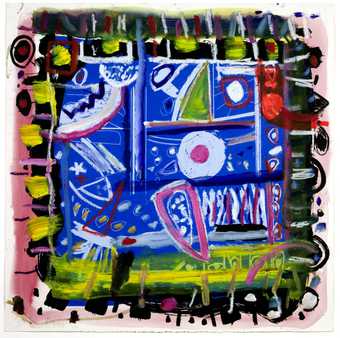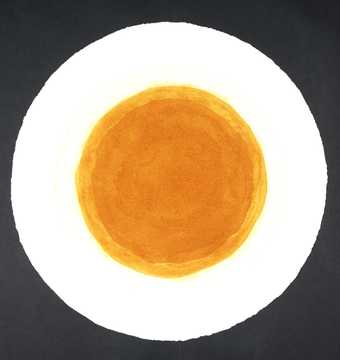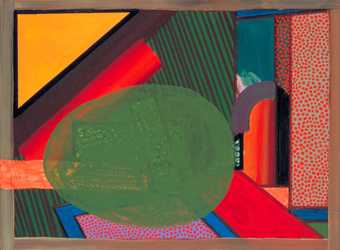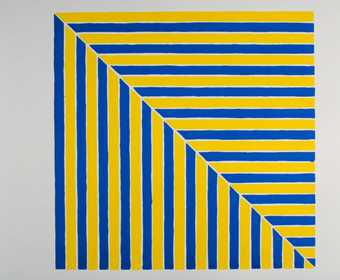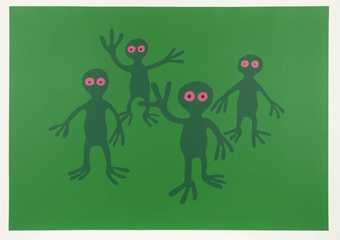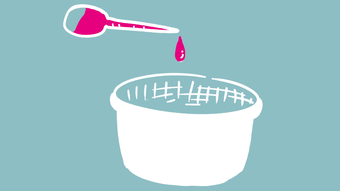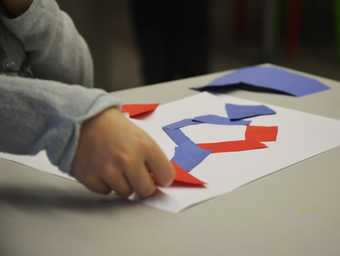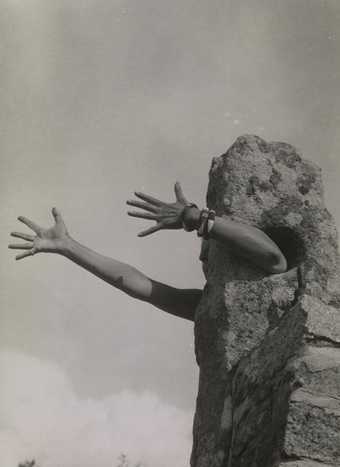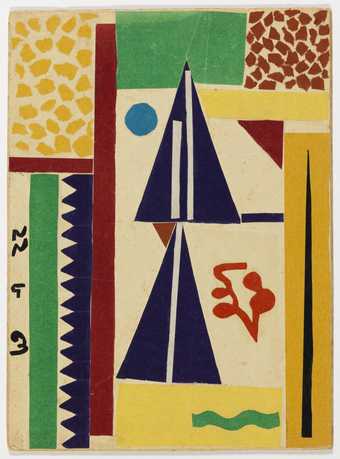
Benode Behari Mukherjee
Two Triangles
(1957)
Tate
Introduction
All art makes use of shape and colour in some way. Your eyes can be drawn to certain parts of an artwork when shape and colour is used correctly. Artists use colour to express themselves and aim to make you feel something when you look at it. Start discussions about shape and colour with your students by looking at and creating art. This resource is most suitable for KS1 students.
Colour
How is colour used in art? Frank Bowling is an artist who believes that colour is as important in telling a story as the subject he paints. Bowling layers colours and uses splashes, drips and smudges to create different effects. His mainly uses colours, as opposed to objects and figures, to create emotion.
In his painting Whose Afraid of Barney Newman Bowling uses bright colours and blurred edges. Does his painting look like anything to you? Did you know these are the colours of the Guyanese flag?
Arthur Hughes, who was part of the Pre-Raphaelite Brotherhood, used colour in a different way to Bowling. The Pre-Raphaelites believed the object was as important as colour. They used colour to reflect the world around them as closely as possible.
Let's explore the different ways colour is used.
Red
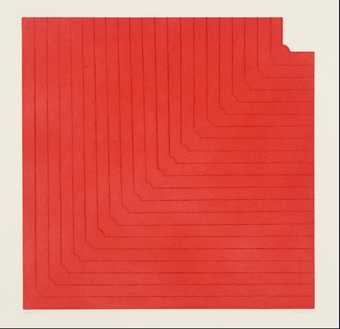
Kim Lim
Red Aquatint
(1972)
Tate
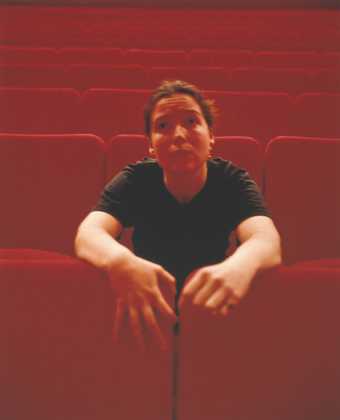
Sam Taylor-Johnson OBE
Red
(2000)
Tate
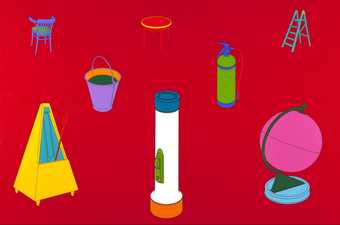
Sir Michael Craig-Martin
Knowing
(1996)
Tate
Green
BLUE
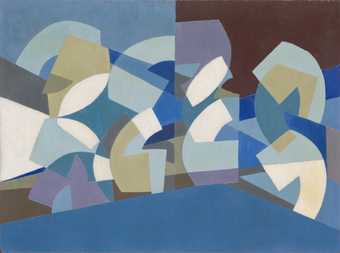
Saloua Raouda Choucair
Composition in Blue Module
(1947–51)
Tate
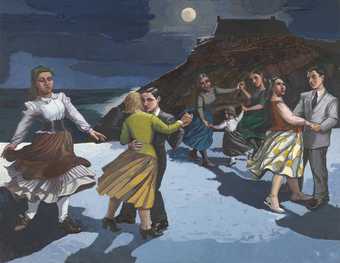
Paula Rego
The Dance
(1988)
Tate
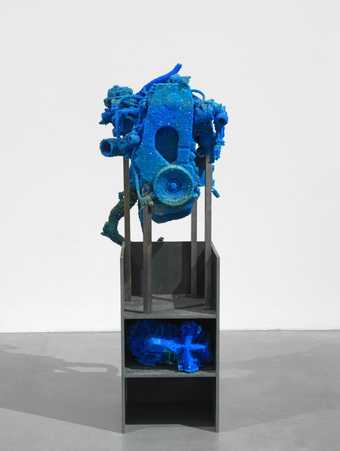
Roger Hiorns
Untitled
(2006)
Tate
YELLOW

Patrick Heron
Yellow Painting : October 1958 May/June 1959
(1958–9)
Tate
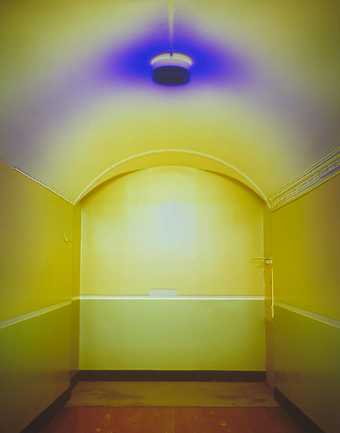
Catherine Yass
Corridors
(1994)
Tate
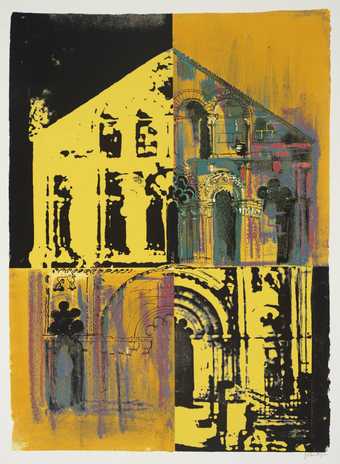
John Piper
Petit Palais: Yellow and Yellow
(1972)
Tate
Multi-colour
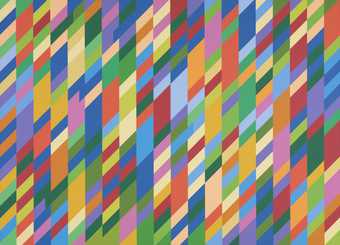
Bridget Riley
Nataraja
(1993)
Tate
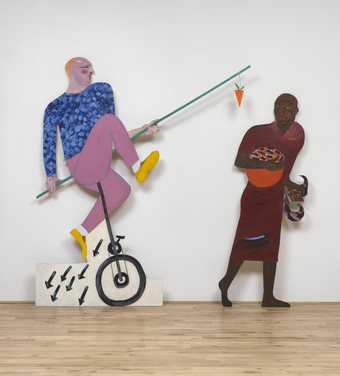
Lubaina Himid CBE RA
The Carrot Piece
(1985)
Tate
© Lubaina Himid, courtesy the artist and Hollybush Gardens, London
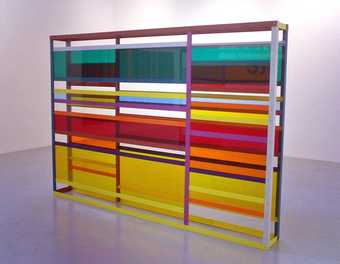
Liam Gillick
Returning to an Abandoned Plant
(2007)
Tate
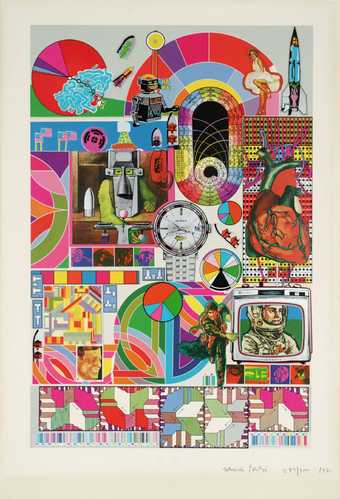
Sir Eduardo Paolozzi
Bash
(1971)
Tate
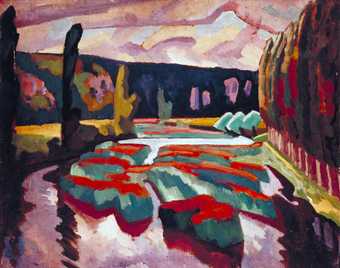
Roger Fry
River with Poplars
(c.1912)
Tate

Fiona Rae
Untitled (yellow)
(1990)
Tate
Lets discuss!
Here are some questions you can ask your class to start a discussion about colour:
- What do different colours make you think of?
- How do the colours make you feel?
- Which colour combinations you think go together?
- What kind of stories can be told through colour?
Shape
From sharp corners, curved edges and towering sculptures, shape is used throughout art. Geometric shapes, like squares and triangles, are mainly found in objects made by humans, like houses, cars and factories. Irregular shapes are more likely to come from nature. Imagine a leaf or a shell. How do you think artists could use them differently to tell a story?
Frank Stella's Hyena Stomp (below) uses sharp edges and corners. He even became known as a 'hard edged artist'. Gillian Aryes used layers of different shapes on top of another. In her artwork The Colour That Was There (in the slideshow above) she uses a rough square as a background. She then mixes circles, rectangles, curved lines and bright colours to give her work depth. Below are more examples of different shapes in artwork.
Squares
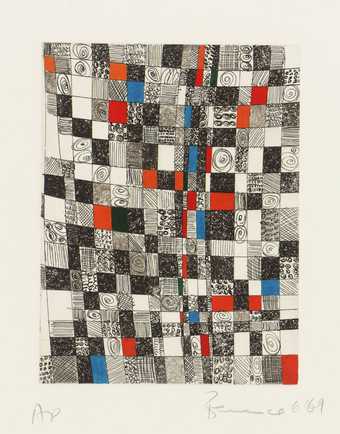
Berenice Sydney
Little Squares
(1969)
Tate
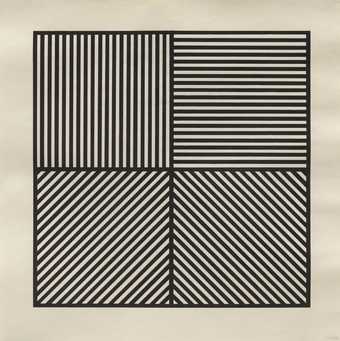
Sol LeWitt
A Square Divided Horizontally and Vertically into Four Equal Parts, Each with a Different Direction of Alternating Parallel Bands of Lines
(1982)
Tate
Triangles
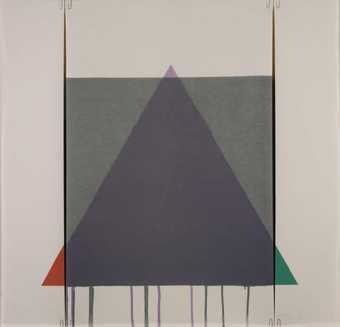
Richard Smith
Triangles
(1978)
Tate

Benode Behari Mukherjee
Two Triangles
(1957)
Tate
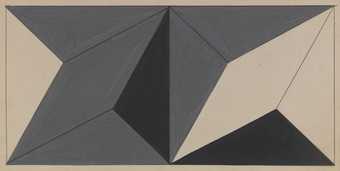
Lygia Clark
Planes on Modulated Surface (Study) (61)
(1957)
Tate
Circles
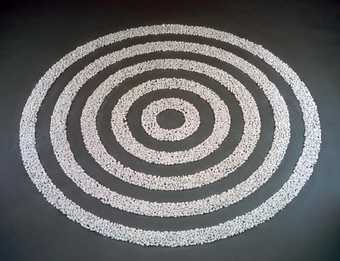
Richard Long CBE
Small White Pebble Circles
(1987)
Tate

Dame Barbara Hepworth
Two Forms (Divided Circle)
(1969)
Tate
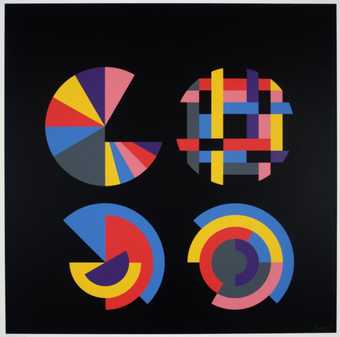
Herbert Bayer
Four Segmented Circles
(1970)
Tate
Three-dimensional shapes
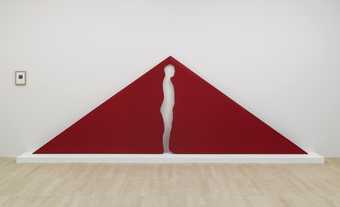
Rebecca Horn
In the Triangle
(1973–4)
Tate
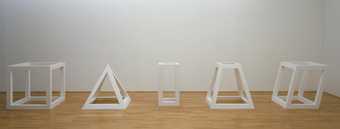
Sol LeWitt
Five Open Geometric Structures
(1979)
Tate
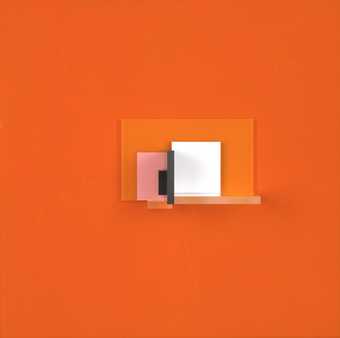
Mary Martin
Perspex Group on Orange (B)
(1969)
Tate
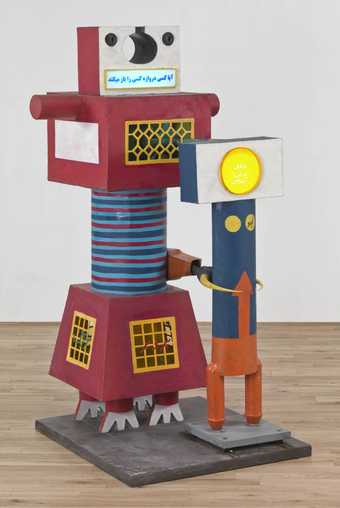
Parviz Tanavoli
The Poet and the Beloved of the King
(1964–6)
Tate
Let's discuss
- What kind of emotions or personalities can shapes hold?
- Do some shapes look more masculine than feminine? Why do you think that is?
- Lets go on a 3D shape hunt! What 3D shapes can you find round a classroom or in your house?
- How does scale affect shape? What's the difference between loads of tiny squares and one giant square?
Five minute activities
Shape
Grab some colouring pencils and have your class draw out objects using only shapes. For example, draw a tree out of triangles, draw a computer out of circles.
Colour
Have some print outs of different objects and have your group colour them in unnatural colours. Colour a house green or a dog blue. What effect does it have on the drawing?
Portraits
Notice how each artist has used shape and colour in a different way to do their portraits? Gary Hume uses bright pastel colours and soft shapes to create his portraits. In Hume's Young Woman, notice how the colours of the eyes are different from one another? What effect does this have on the portrait? In Picasso's Weeping Woman, he uses detailed lines and angles. Can your class spot the different shapes and colours within his painting?
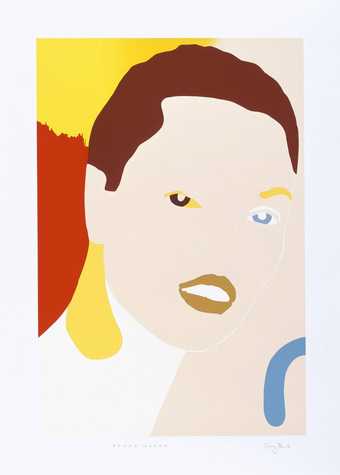
Gary Hume
Young Woman
(1998)
Tate
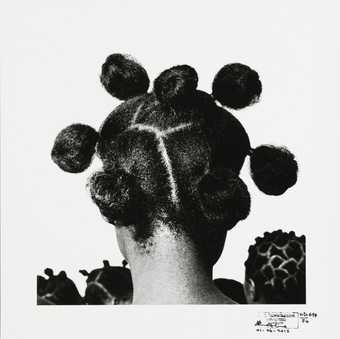
J.D. Okhai Ojeikere
Untitled (Mkpuk Eba)
(1974, printed 2012)
Tate
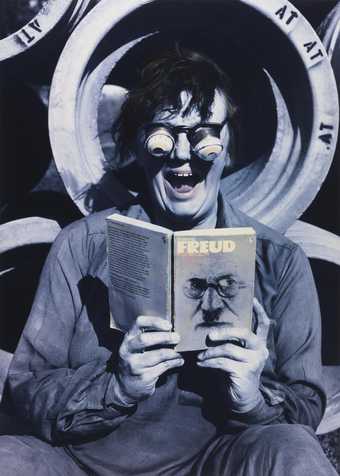
Jo Spence, with Terry Dennett
Remodelling Photo History: Revisualization
(1981–2)
Tate
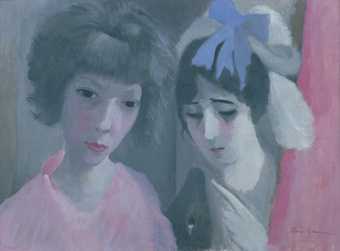
Marie Laurencin
Portraits (Marie Laurencin, Cecilia de Madrazo and the Dog Coco)
(1915)
Tate
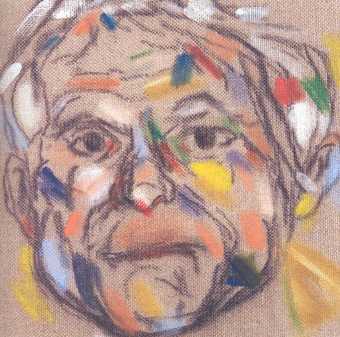
R.B. Kitaj
Self-portrait
(2007)
Tate
Let's Discuss!
Look at all portraits above and ask your class the following questions:
- Who are they?
- How would you describe the portraits above? Girl, boy, both or neither?
- How old do we think they are?
- What sort of houses do they live in?
You could even get your pupils to create a story for the portraits and share with the rest of the class.
30 minute activities
Make a self portrait
You will need:
- A4 White paper
- Scissors
- Glue
- Paint
- Various cut out shapes
Instructions
- Draw an outline of a face and shoulders
- Fill in the features, such as lips and eyes, with either the cut out shapes
- Paint the background with different colours
- You can use their pictures to do an exhibition or display of abstract self portraits. Make a story out of the portraits. What would they say?
Make an identity flag
Using Frank Bowling's Whose Afraid of Barney Newman as inspiration, have your pupils class create their own personal flags. They can choose any colours that represent their identity in terms of personality, interests, gender and background. You can even get your class to explain why the picked the colours and what they mean to them.


